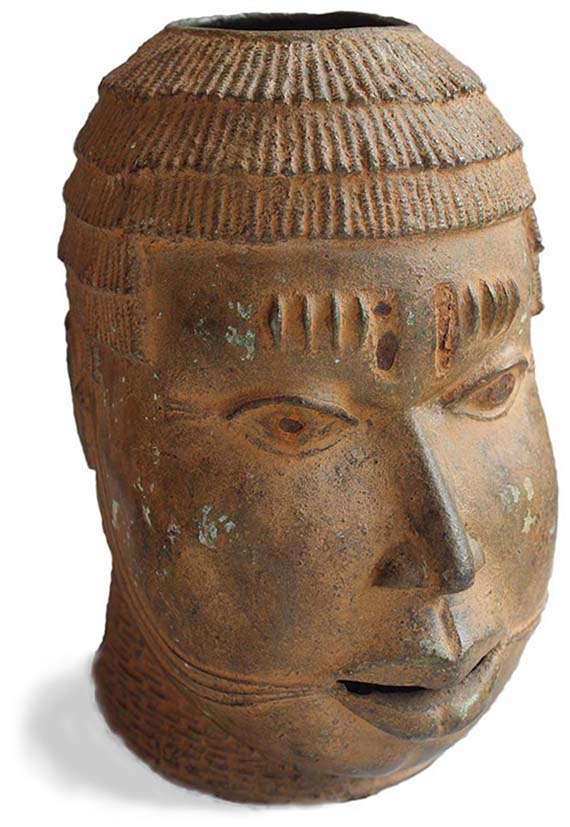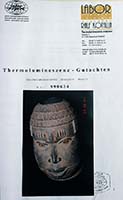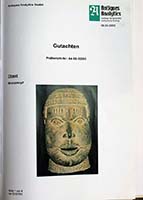| Galerie Peter Herrmann | ||||
| Ancient Art from Africa | ||||
 |
| Photo: Peter Herrmann. 2014 |
| Expertises | Head |
 |
 |
 |
Benin, Nigeria appr. 1500 Bronze 24,5 cm |
| Head |
Google translation of the german text May 25, 2019 Light patination with traces of copper acetate indicate an excavation patina. Vertical tattoos on the forehead with fragments of iron inserts on the two middle incisions. Further tattoos from the mouth to the back can be stylistically compared with whiskers of a cat. They are, until recently, often, but less and less common in the Yoruba. These features are significant, but anthropologists argue that the hairstyle is an "Ibo" hairstyle and therefore a head of this sort the head of a slain enemy. You probably have to reject this description, which is haunted by literature. It can be assumed that some heads had such a background, but the majority of the known heads are to be regarded as pure commemorative heads without blood. See the text by Dorina Hecht for a comparable head. Interesting the tendency of naturalism in reproduction. Through the centuries, this type of memorial head changed more and more into an abstract representation. The decorated with coral neck has a simple effect on this head. Until the 18th century, the royal fashion changed and the coral collar is sometimes pulled up over the mouth. To what extent this points to different hirarchies has not yet been explored. If, in the next few years, some flawed stylistic descriptions constructed by ethnological science are shelved as taboos, this head is relevant to research. He can be seen as one of the oldest of his type and can thus be seen as an archetype of a stylistic assignment. 0.5% aluminum in the patination was decrypted by Aventis in the attached analysis as a silicate and deciphered as a surface contaminant. 0.29% aluminum in the alloy itself went through in 1999 as harmless. The analysis did not distinguish between silicate, oxide and solid aluminum, which could play a role in future research. Actually important here is the following circumstance: A short time after creating the analysis, the assertion went unchecked, the presence of aluminum, in whatever state, is a clear proof of "new". (See: Age assignment by P. Herrmann) As this statement was made by a television professor, it quickly reached a topicality among ethnologists, whose longing for recognition by a compliant professor in the tradition of primitive stare was breastfed. Prof. Dr. Ernst Pernicka, whose expertise was rejected in the following years in several processes, thus turned against Dr. G. Humid from Aventis. A Mr. Neunteufel, who took over the dissolved laboratory of Aventis, acquired their expertise with the same. At the beginning of his career he followed the theories of Dr. med. Damp of Aventis, took over at some point, however, the claim Pernickas. It remains a mystery to outsiders, whether he told customers to whom he had initially certified old objects, after his 180-degree turn to have been wrong and their objects must be logically and subsequently considered to be "new". However, this is hardly to be assumed, since otherwise he would have had legal proceedings in view. Significant to the memorial head next to the TL of Kotalla is therefore only the expertise of Aventis. Too much suspicion arises that Neunteufel the company Antiques Analytics the analysis of Aventis unreflected took over. It is therefore to be seen as an early indication of his technical incompetence and was therefore only published here as an exception in this head. If Aventis made a tiny hole at the bottom of the base, Neunteufel bristly sawed out almost an entire square centimeter from the historically significant object, adding unnecessary optical damage. He added this unqualified method of mutilation as a trademark to all objects given to him. This extraordinary head was part of a historic agreement. He had the archive number 433 in a jointly produced list of the National Commission for Museums and Monuments and René David from 2001. This head explicitly exempted from the claim of national treasures is thus one of the precursors of far-reaching clarifications. As a result, a number of Benin, Ife and other cultures of southern Nigeria were provided with official export documents, redrafting the definition of "national treasures". Thanks to the efforts of René and Jean David and the legal disputes of our gallery, this creates new legal certainties for the trade and the collectors. The fact that such a head is offered again in the trade in Lomé in 2014 is a rare circumstance. |
(german text, Peter Herrmann, 2014) Text by Dorina Hecht describing a similar object |
| Auction results |
Sotheby's New York. 1986. Head Benin-Culture. No information concerning age. No information if there is a provenience. € 683.904,-
Auktionshaus Koller. 2005. Kopf Benin-Kultur. Benin 17.-18 Jh. € 423.060,- Auktions Results at Sotheby', Christie's, ... Paris, New York |
| Similar objects | Illustration |
Ekpo EYO, Frank Willett: Kunstschätze aus Alt-Nigeria, Mainz 1983, S. 136. |
Staatliche Museen zu Berlin, Ethnologisches Museum |
Felix von LUSCHAN: Die Altertümer von Benin, Band 1-3, Berlin 1919, Tafel 55. |
Till Förster: Kunst in Afrika, Köln 1988, S. 101. |
Nationalmuseum Lagos |
Schätze aus Alt-Nigeria. Ministerium für Kultur, Berlin (Ost) 1985, S. 138. |
Museum für Völkerkunde zu Leipzig, Grassimuseum |
Kunst aus Benin. Afrikanische Meisterwerke aus der Sammlung Hans Meyer, Grassimuseum, Leipzig 2002, S. 73. |
General Pitt Rivers's Museum at Farnham, Dorset |
Augustus Henry PITT-RIVERS: Antique Works of Art from Benin, London 1900 (Reprint 1971), S. 31. |
Frank WILLETT: Ife. Metropole afrikanischer Kunst, Bergisch Gladbach 1967, S. 189. |
British Museum, London |
William B. FAGG: Bildwerke aus Nigeria, München 1963, S. 41. |
Galerie Peter Herrmann |
| Art Loss Register: |  |